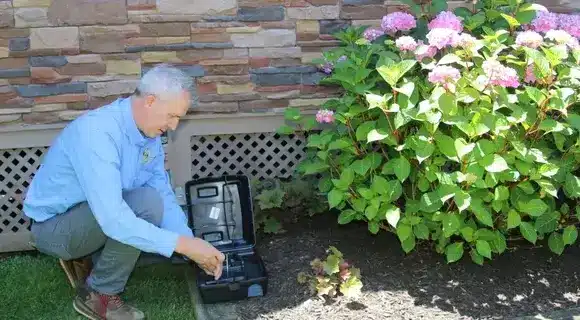






Pricing starting at just $39/month
You spot a dropping in the pantry. Then another under the sink. Maybe you hear scratching in the walls at night. You set a trap, but nothing. Or worse, you catch one, but you know that means there are more. The stress of dealing with rodents isn’t just about the mess—it’s about the uncertainty. How bad is the problem? How long have they been here? Are they spreading disease?
Rodents aren’t just annoying. They chew through wires, damage insulation, contaminate food, and multiply fast. If you don’t get ahead of the problem, you could be in for an uphill battle. Many homeowners waste time and money on store-bought solutions that barely scratch the surface.
Not all rodent control programs are built the same. We designed ours to handle one of the worst rodent-infested areas in Northern Virginia: Old Town Alexandria. With its historic homes, tight spaces, and endless entry points, Old Town is a breeding ground for mice and rats. If our program works there, it works anywhere.
We don’t rely on guesswork. Our four-step rodent protocol is designed to not only get rid of rodents but to keep them from coming back.
Rodents don’t just wander in randomly—they follow scent trails, food sources, and shelter. Before we do anything, our licensed technicians conduct a 78-point home inspection to find out exactly where they’re getting in, nesting, and feeding. We don’t just look for the obvious; we know where to find the hidden signs of activity that most people miss.
We strategically place tamper-proof bait stations in key areas based on our inspection. These aren’t random placements—they’re positioned based on known rodent behavior.
Rodent control isn’t a one-and-done job. We return at key intervals—typically at 1 and 3 weeks after the initial treatment—to check station activity, remove dead rodents, and make adjustments as needed. If activity remains high, we adapt the approach to ensure control is achieved as quickly as possible.
Most rodent problems fail because homeowners think a single treatment is enough. The reality? Without a long-term prevention strategy, new rodents will move in. That’s why we offer ongoing maintenance programs, starting with quarterly check-ups. In this phase, we may additionally recommend fixes to entry points into your home.
Rodents don’t just disappear on their own. You need a program designed for serious infestations, tested in one of the toughest rodent hotspots in Northern Virginia. Our protocol is built for results, and with free unlimited callbacks, you can be confident that we won’t stop until your home is rodent-free.









We’ve been locally owned and operated for over 57 years, and our programs are built on thousands of hours of research. We’ve eliminated 9 of the harshest chemicals in our industry, choosing better alternatives like Essentria, Sentricon, and Borate-based solutions. We offer free unlimited callbacks, real expert phone consultations, and no phone trees or outsourced customer service.
Yes, we do. We can usually get someone to your home within one business day or less. Contact us to check availability.
Yes! We don’t lock you into long-term contracts. If you ever need to cancel, just give us 30 days’ notice.
The materials we use are products we’re comfortable using in our own homes, day in and day out. Every product we apply is EPA-approved, and we’ve specifically eliminated 9 common industry products that didn’t meet our standards.
We accept both check and credit card payments.
Yes! If you pay for the full year upfront, you’ll save 5% on your total cost.
Yes, we do offer one-time treatments. However, whether a one-time service will solve your issue depends on the pest and severity of the problem. Contact our expert licensed technician for an assessment and recommendation.
No, we do not handle wildlife issues like raccoons, squirrels, bats, or other animals.
We do offer some commercial services. Please contact us with details about your industry and property, and we’ll let you know if we can help.
We treat for American roaches, ants, box elder bugs, brown banded roaches, camel crickets, centipedes, cigarette beetles, clover mites, drugstore beetles, spiders, springtails, earwigs, field crickets, fire brats, fleas, German roaches, ground beetles, Indian meal moths, lady bugs, stink bugs, termites, mice, millipedes, oriental roaches, pill bugs, rats, rice weevils, silverfish, smokeybrown roaches, sow bugs, ticks, wasps, mosquitoes, carpenter ants, carpenter bees, hornets, and yellow jackets.
We do not handle bed bugs, wildlife issues, snakes, birds, squirrels, drain flies, fruit flies, raccoons, gophers, voles, possums, skunks, chipmunks, foxes, or bats.
Our 4-step rodent protocol includes a full inspection to identify hotspots, placing tamper-proof bait stations, early follow-ups to assess effectiveness, and long-term maintenance to prevent reinfestation. In some cases, we also use snap traps or exclusion techniques.
Yes! Our seasonal protection plans keep your home pest-free year-round. Each visit is timed to address the pests that are most active during that season, and if you ever see an issue between visits, we’ll come back at no extra charge.
After every service, we send you an email report detailing what was done, what products were used, and any recommendations our technician may have for your home.
Better Termite & Pest Control has been family-owned and operated since 1968. We’re now in our third generation of serving the DC Metro area.


